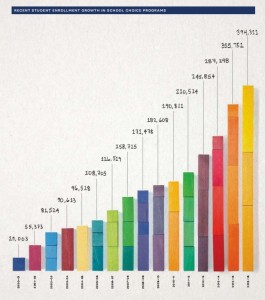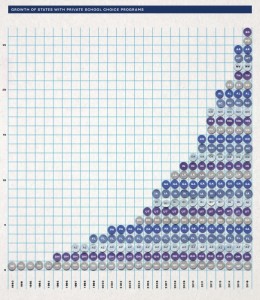
More states are creating educational choice programs, more students are using them, and lawsuits taking aim at them failed more often than they succeeded.
That’s the state of the school choice movement in 2016, according to the American Federation for Children, an advocacy group that issued its annual yearbook last week. Here’s a quick breakdown some trends it highlights.
Growth
For the first time, a clear majority of U.S. states have some law on the books offering private school choice — vouchers, tax credit scholarships, education savings accounts, or, as in Florida, all three — to their students.
And the number of students using private school choice scholarships has risen to more than 394,000.
Lawsuits
The legal scoreboard for the past year reads 3-1. Lawsuits challenging school choice programs were defeated in North Carolina, Oklahoma and Georgia. A lawsuit challenging a Douglas County, Colo. voucher program succeeded, but supporters of the program are appealing that case to the U.S. Supreme Court, making legal arguments that mesh with a case the court has already agreed to hear, which takes aim at Blaine Amendments.
Meanwhile, a challenge of Nevada’s new education savings account program is still being heard. And an appellate court will hear a lawsuit challenging Florida’s tax credit scholarship program next week. Last year, a Tallahassee judge dismissed the case.
Accountability
Florida is one of three states (Alabama and Louisiana are the others) with the most thorough regulation of their tax credit scholarship programs, according to the report. All of them have health, safety and financial safeguards for private schools that accept scholarship students, financial accountability for scholarship funding organizations (Step Up For Students, which publishes this blog, is the largest such organization in Florida), and some academic testing requirements.

Louisiana’s tax credit program operates alongside a statewide voucher program and is relatively small, but Florida and Alabama’s programs are noteworthy because they provide scholarships that, while considerably less than what public schools in their states receive per student, are greater than the $2,580 national average per-student tax credit scholarship. Perhaps the greater accountability requirements help justify scholarship funding levels necessary to give low-income students, whose families likely can’t afford heavy out-of-pocket tuition payments, meaningful access to private schools.
Conclusion
Scanning the report, the trends all seem to point in one direction. And yet, despite their steep growth curve, the numbers are also cause for humility. The nearly 400,000 students enrolled in private school choice programs (roughly a quarter of whom are Floridians) still represent less than one percent of elementary and secondary students in the United States.


